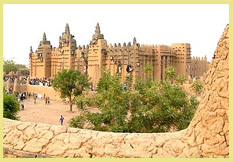




Forests
 Evergreen tropical rainforests - shown dark green on the map - cover about 12% of Africa and are the richest areas of the continent biologically. The rainforests are found in three quite distinct areas, each supporting a wide array of unique species. These are (1) the Congo Basin rainforests; (2) the ‘Upper Guinea' forests of West Africa (which are separated from the Congo Basin by a dry area between Nigeria and Ghana); and (3) isolated forest ‘islands' on mountains, and along the East African coast. Africa's rainforests are not as wet as those on other continents, and have gone through phases of contraction and expansion over the millennia in response to climate change.
Evergreen tropical rainforests - shown dark green on the map - cover about 12% of Africa and are the richest areas of the continent biologically. The rainforests are found in three quite distinct areas, each supporting a wide array of unique species. These are (1) the Congo Basin rainforests; (2) the ‘Upper Guinea' forests of West Africa (which are separated from the Congo Basin by a dry area between Nigeria and Ghana); and (3) isolated forest ‘islands' on mountains, and along the East African coast. Africa's rainforests are not as wet as those on other continents, and have gone through phases of contraction and expansion over the millennia in response to climate change.
Within Africa's 3.5 million square kilometres of rainforests there are just five world heritage sites, covering an area of 63,000 km2. Four of these are in the Congo Basin (Dja Faunal Reserve in Cameroon; Lope National Park in Gabon; Salonga National Park and Okapi Faunal Reserve in the Democratic Republic of Congo) and the fifth (Tai National Park in Cote D'Ivoire) is in the Upper Guinea forest block. There are also three sites along the Great Rift which are primarily rainforest habitats (Bwindi-Impenetrable, Virunga and Kahuzi-Biega National Parks), but these are covered elsewhere. Follow the links to learn more about these amazing places in Africa's rainforests!
Iconic Species: African rainforests are home to our closest relatives - the chimpanzee and bonobo - as well as gorillas and a multitude of monkeys and antelopes that are specially adapted to rainforest habitats. Forest elephants are much smaller than their savanna-dwelling cousins, but no less important as habitat engineers - dispersing rainforest trees over vast distances and maintaining swampy forest clearings (‘Baias') as saltlicks and playgrounds for the wider forest ‘community' of animals.
The present-day distributions of different species owe much to climate change over the millennia, and the ability of individual species to survive (as forests have contracted during dry periods) and re-colonise areas (as warmer, wetter conditions take hold and forests are able to expand). The peculiar okapi - a kind of forest giraffe - occurs only in the north-eastern corner of the Congo Basin; the pygmy hippo is restricted to West African rainforests; and the bonobo (pygmy chimpanzee) occurs only to the south of the great Congo River. Thus conservation of the full range of African rainforest species requires protection of a network of carefully selected sites, each protecting a different suite of species.
Missing Links: The five existing world heritage sites in the lowland rainforests, together with those straddling the Great Rift, constitute an excellent suite of sites which together protect most of the key species typical of Africa's rainforests. A major initiative is currently underway to identify possible additional sites in the central African lowland rainforests (the Central African World Heritage Forests Initiative, CAWHFI), and there is still need to consider world heritage status for the highly distinctive forests of the ‘Eastern Arc Mountains' in Tanzania, as well as the East African coastal forests from Kenya to southern Mozambique.
.jpg)



